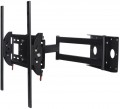Minimum distance from the wall
The smallest possible distance between the wall on which the mount is hung and its farthest protruding point. First of all, the overall compactness of the design depends on the minimum distance: if you do not want the TV to protrude far forward from the wall, you should pay attention to models with a small minimum distance. And if the mount provides length adjustment, this parameter determines the limits of such adjustment.
Max. distance from wall
The maximum distance from the TV mounting point to the wall (in the case of ceiling mounts, to the ceiling) provided by the mount. See "Minimum distance from wall" for details.
Adjustments
The ability to change the position of the TV installed on the mount. Adjustments make it possible to optimally adjust the location of the screen; the more there are adjustments, the wider the customization options.
—
For curved TVs. Stands designed for use with curved TVs. Such TVs are becoming increasingly popular — it is believed that the curved shape has a positive effect on the image quality. Note that the dimensions and curvature of such screens can be different, so the compatibility of the stand with a specific TV has to be clarified separately.
—
Tilt. The ability to adjust the tilt of the installed TV forward and backward relative to the vertical position. It will be useful if the TV is not installed at eye level, and also if the height of the audience changes (for example, if you are sitting on the sofa, then on the floor, depending on your mood).
—
Turn. The ability to turn the TV around a vertical axis, from side to side. This gives a certain freedom in moving around the room — by moving to another point, you can turn the TV in the right direction and watch comfortably.
—
Depth adjustment. The ability to move the TV back and forth relative to the point of attachment to the wall without changing the angle of the screen. Can be used in combination with turn — for example, if at a selected
...point in the room an object on the side of the TV is blocking it, the screen can be pulled out from behind the obstruction and turned for the optimal viewing angle.
— Slide. The ability to move the TV from side to side relative to the point of attachment to the wall without changing the angle of the screen. This can be useful, for example, when rearranging: by moving the TV to the side, you can install a piece of furniture next to it that did not fit there before, without rearranging the mount itself. It can also be used in conjunction with turn, similar to depth adjustment (see above).
— Rotation. The ability to rotate the installed monitor around the horizontal axis, in other words, the ability to rotate the screen from a horizontal position (“landscape” orientation) to a vertical (“portrait”) one. In everyday use, this function is practically not in demand, and therefore is rare. At the same time, it can be useful for specialized purposes — for example, if the screen is used as a monitor and you need to work with vertically stretched materials (graphics or texts).
— Height adjustment. The ability to adjust the height of the TV on the mount. Allows you to optimally adjust the position of the screen relative to eye level, surrounding objects, etc.Upward tilt angle
The maximum upwards tilt angle from the vertical of the installed screen. The larger the tilt angle, the wider the adjustment possibilities, however, in fact, an angle of more than 5° is rarely required.
Turn angle
The angle within which the screen installed on the mount can rotate. Measured from far left to far right. In modern models, it can reach 180°.
Rotation angle
The angle within which the screen installed on the mount can rotate. Rotation refers to turning around a horizontal axis perpendicular to the screen; see "Adjustments" for details. And the angle is usually indicated from one extreme position to another.
According to this parameter, two categories of mounts can be distinguished. In one of them, the rotation angle is small — about 10 – 15 ° — and this feature is mainly intended to compensate for inaccuracies made during the installation of the structure: even if the mount hangs slightly unevenly,
rotation allows you to set the screen straight. The second variety is models with a rotation angle of 180° and above (up to 360°); they allow user to rotate the screen from landscape to
portrait and vice versa.

